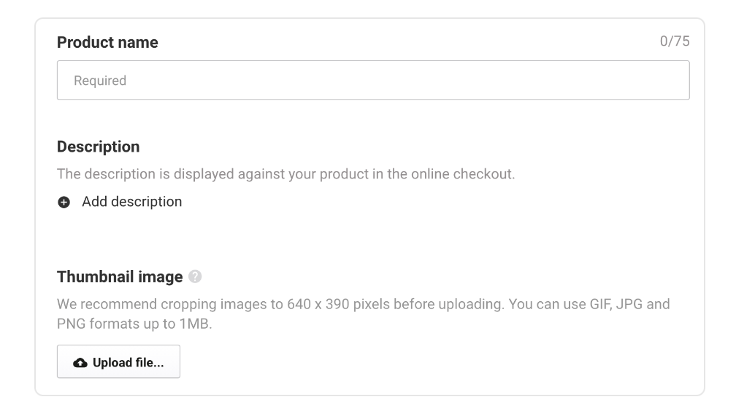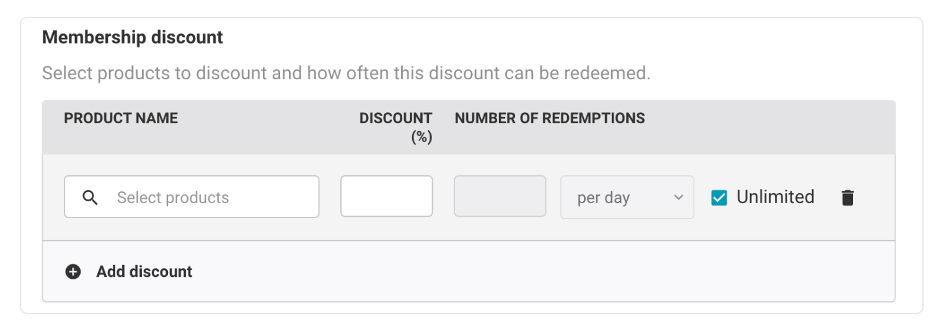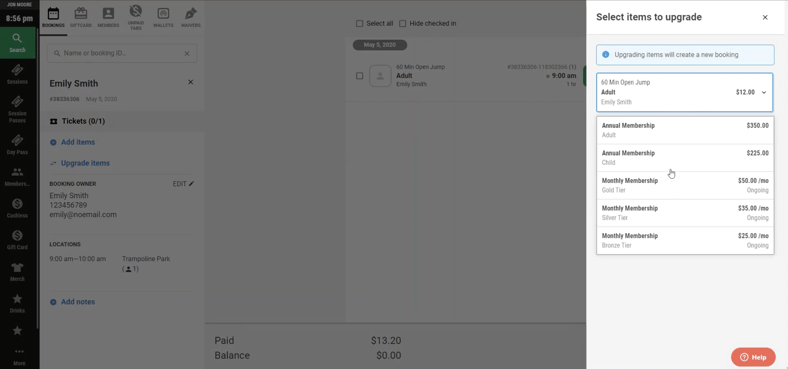Getting guests to return to your venue time and time again builds greater engagement and brand loyalty and will help increase revenue for your leisure and entertainment business.
And the best way to do just that is to offer a membership program. It not only increases the chance of guests returning but helps to maintain better relationships with your most satisfied guests.
5 membership program ideas to help grow your business
1. Build and price your memberships program accurately
If you haven’t already set up a membership program, consider this your notice to start. It doesn’t have to be an overwhelming task to begin, and if your venue already runs smoothly and your guests give you rave reviews, then you’re halfway there!
Think of your membership program as a way to tailor your existing offerings to different guest needs. For example, if you run a trampoline park, offering a ‘Family Membership’ could be a great way to increase visitation and provide real value to those guests who would ideally like to visit regularly.
It’s essential to get your membership program pricing right, appeal to guests, and ensure the numbers work for your business. There’s a balance between charging too little and too much, so start by looking at your average guest value.
Let’s say that’s $15 (which might equal the price of a single session at your venue). You could create a basic monthly membership program, giving a guest unlimited visits for $15 a month. The value to local or regular guests is clear.
With a minimum membership period in place – start with three months – you’re already increasing your revenue compared to that average guest spend figure.
And by adding different membership pricing can be as simple as Gold, Silver, and Bronze tiers; you not only appeal to a broader selection of guest types but can also provide opportunities for upselling over time.
With ROLLER you can create a membership product that can easily be configured to different guest needs, with options to include exclusive access to products and additional discounts.

2. Offer member-only perks to drive FOMO
In addition to providing an opportunity for repeat visits to your venue, your membership program is a great way to incentivize guests via special offers, exclusives, and perks only members can have.
Some popular ones might be discounts on food & beverage items, retail discounts, or exclusive merchandise like branded t-shirts or hats. Free parking, special entry times, birthday bonuses, or more exclusive member-only events are other types of incentives that can resonate.
Think about what else you could be offering guests based on the business you operate, especially things that might appeal to your higher-spending guests.
ROLLER’s customizable membership programs let you set up custom discount rules, so members automatically get special pricing, even when booking online.

3. Drive advocacy amongst your existing members
We know word-of-mouth recommendations are one of the most powerful referral channels for any business.
So what about using your membership base to help drive more engagement with new members? By setting up a simple membership referral program, you can create a win-win situation for your members, future members, and your business.
For example, provide a guest pass for existing members to share with their networks and reward every new member they bring in with a referral discount or other type of incentive.
You’ll keep your members more engaged, guests will appreciate the opportunity for a free trial, and you’ve got another channel to help bring in new members!
4. Partner with other local businesses to expand your member network
There’s real power in the local community, and partnering with other local businesses can also be a great way to drive more members through cross-marketing promotions.
Not only do you each get to expand your marketing reach through new channels, but using a local business to promote your membership can add some authenticity to your message, especially if the local business has a loyal customer base.
Suppose you’re partnering with a food business. In that case, you might find great ongoing co-marketing opportunities, such as expanding your food and beverage options with regular specials for members.
5. Promoting your membership program at check-in and online and after a visit
Promoting your membership program should be a crucial part of your regular marketing strategy - both online and in-venue.
If guests buy tickets through your website, this can be a good opportunity for initial promotion. And even if they aren’t ready to commit to a membership at this stage, it’s a good way to promote future value, especially if their first guest experience is great.
On-site promotion is a chance to build on that real-time guest experience. So make sure you’re promoting your membership program through signage, audio announcements, and staff interactions.
You could also remind guests that they can upgrade their ticket on the spot and only need to pay the difference between their ticket purchase price and a membership. This makes it super easy to not only give your guests a great experience but a great opportunity!
ROLLER’s POS makes it quick and easy to upgrade a standard ticket to a membership.

Another way to keep that excellent guest experience fresh in the minds of recent visitors is using post-visit marketing to remind them of membership options by sending automated upgrade offers after a visit.
A simple email sent within a week of visiting might just be the prompt needed for some guests to take you up on your membership program. Offering a deal where guests can upgrade their already paid ticket to a membership just by paying the difference can further demonstrate real value.
ROLLER customers can take advantage of integrations with marketing automation software programs like Campaign Monitor, making sending effective, personalized, and targeted messaging easy.
7 tips and best practices for a successful membership drive
To know if your membership program is a success, you’ll want to be tracking some specific marketing performance measurements, which will help you reach and stay on track with your membership program goals more accurately.
Here are 7 of the top metrics to monitor:
1. Figure out how engaged your audience is
Ideally, you want your audience, or the desired audience, to engage with any marketing activity you do.
Of course, in reality, that’s not always the case. An excellent way to measure this is through your engagement rate, which will measure the interaction with specific marketing activity.
We’ve all heard of ‘liking’ a post, which is probably the most common social media engagement metric; however, your engagement rate will likely be made up of multiple metrics depending on the digital channel.
For example, your website's engagement rate might include the time spent on a page, the number of different pages viewed, or the number of inquiry forms completed.
If you have a Facebook page, this might be the number of clicks, comments, or shares of a post. Your engagement rate gives you measurable metrics that you can track over time and are especially useful for measuring the effectiveness of specific campaigns.
2. Identify what’s making your existing members leave
Churn happens when a guest no longer visits or purchases from your venue. Sometimes guests simply don’t renew their membership or cancel it for various reasons, and knowing your churn rate will help you to better measure any loss in recurring payments.
ROLLER’s Membership Growth report can calculate your churn figure. Still, a basic churn rate formula takes the number of lost guests and divides it by the total number of customers you had at the start of a period (e.g., the beginning of a month) and multiplies it by 100 to give you a percentage figure.
Knowing your churn rate may also highlight other problems within your business, from issues with pricing to customer service, so it’s an important metric to stay on top of.
3. Create opportunities to grow guest lifetime value (LTV)
An important but often overlooked KPI is your guest's lifetime value. This calculates how much a guest is likely to spend with you throughout their entire relationship with your business.
We touched on churn earlier, which is the greatest threat to your LTV, and it’s also easier to market to your existing guests and members than to acquire new ones.
Getting your membership program right is one of the best ways to protect your LTV, so building long-lasting relationships is critical.
A simple LTV calculation focused on memberships would be ‘average monthly revenue per member’ multiplied by the ‘expected lifetime of a membership’ to give you a membership lifetime value.
4. Work to reduce your cost of customer acquisition (CAC)
Put simply, CAC is the amount of money you’re spending to get, or acquire, a new customer. Again the lower this cost, the better it is for your business
If you’re using digital marketing channels, this would be the amount of money you spend on paid search, retargeting, and banner ads and then dividing that cost by the number of new customers you acquire
Ideally, you would measure this at least monthly or for the duration of specific campaigns you are running. Say you spend $500 on digital advertising in one month, and from that, you bring in 50 new customers, then your CAC would be $10.
5. Know what your CAC payback period looks like
The customer acquisition cost (CAC) payback metric is the amount of time, for example, months or even years, it takes your business to recover your upfront customer acquisition costs.
In financial terms, it’s been described as how long it takes to reach a break-even point and is an excellent way to measure cash flow and profitability. There are a few different ways you can calculate your CAC payback, but at its simplest, it’s taking your CAC and dividing it by the annual revenue per customer.
6. Focus on increasing return on ad spend (ROAS)
ROAS is a marketing performance metric that measures the revenue earned for every dollar spent on advertising.
For example, if you’re spending $200 a month on Google Ads (also called PPC or pay-per-click advertising), you’ll want to know how much revenue this generates. If you make $1,000 for every $200 spent on advertising, then your ROAS is 5:1
The higher the ROAS, the better for your business, as you ideally want to generate as much revenue as possible for as little cost. For more insights and how to apply it to your business, we recommend looking at this simple ROAS guide from Hubspot.
7. And increase your return on investment (ROI), too
Looking at your ROI on marketing can help you determine how profitable your activity is. Similar to your ROAS, your ROI looks at how much you spend on any marketing activity; ideally, for every dollar, you spend on marketing, it’s bringing in more.
For example, suppose you paid $200 for advertising in a local events publication. In that case, you’ll want your ROI to be well above the initial advertising cost to make it worthwhile for your business.
Different types of marketing activity will have other ROI metrics, and costs could include the number of leads, average sales price, and lead-to-customer rate.
Getting your membership program right is your ticket to more predictable revenue
While these ideas can help you deliver a successful membership program and increase engagement with your most satisfied guests, it’s important to remember that even with the best systems in place, you must continually prove the value of membership to your guests.
Get these things right, and you can be rewarded with repeat visitation, a more loyal audience, and a recurring revenue model that’s more dependable and forecastable.



